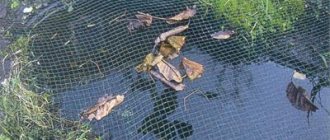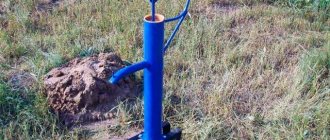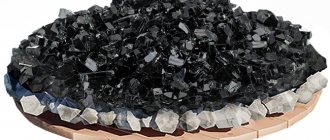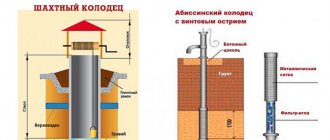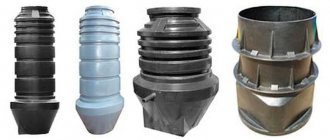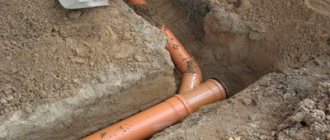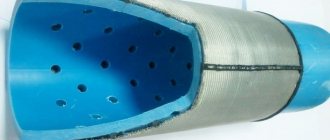Once again about the “search for water” on the site. Well or well? Which is cheaper? Aquifer
I can say with complete confidence that the quality of water from a well or borehole greatly depends on how it is equipped. From personal experience, I have often encountered the fact that water from a deep well on limestone turned out to be worse than water from a well on sand.
I will outline a number of key, basic differences between the water chemistry in these hydraulic structures. They are determined by the degree, method of natural filtration and the possibility of interaction with surface water layers.
Below I will answer the most common questions faced by those who are faced with a choice between a well and a borehole.
Well or well?
When deciding this issue, I would not rely primarily on the quality of the water, but would recommend proceeding from personal needs.
IMPORTANT!
2 types of wells There are two types of domestic wells - for sand, for limestone.
Wells for sand differ little in flow rate and water quality from wells, so in the table and further below I will consider artesian wells for limestone. Their main feature is that their depth can reach 250 meters or more, and the water in them comes from solid limestone aquifer. It does not interact in any way with perched water, therefore its chemical and qualitative composition is constant, as is its flow rate, regardless of the time of year or the volume of precipitation. In the table below I have outlined the pros and cons of each of the hydraulic structures.
| Well | Well | |
| Housing type | Country house for seasonal stay | Large house for permanent residence |
| Purposeful use of water | For irrigation of the garden | To cover all household and gardening needs |
| Required volumes | Small, periodic | Large, permanent |
| Water quality requirements | Low, it is not planned to use it to ensure the operation of household equipment | High, preferably constant quality with unchanged chemical composition |
So, let me summarize this issue. If the requirements for water quality and flow rate are low, and it is not needed for constant use, then choose a well. Otherwise, only an artesian well. As for material costs, a well 20 meters deep will cost you approximately 80,000-100,000 rubles without soil removal. Artesian well 70 meters deep with a steel pipe with a diameter of 133 mm - 155,000-160,000 rubles.
Helpful advice The price difference between a well and a well is almost twofold, so I advise you to first read the experience of your neighbors. The lowest groundwater level is in March and August, so I recommend inquiring about the flow rate and quality of water in wells during these periods. If the aquifer is good, then the well will cope with its tasks no worse than a well, and you will not have to overpay.
Find out what the current prices are for drilling wells in Moscow and the region (opens in a new window).
Finding the reason
First of all, you need to determine the reason for the drop in level. If this happened due to sedimentation of silt, then the solution is very simple: just clean the bottom. The pump may also be to blame for this situation. You need to check its location and make sure that it is not too close to the bottom. If this is not the case, then correcting the situation will not be difficult. This is where the simple recipes end.
The situation is much more complicated if the level in your neighbors has also dropped. This state of affairs could have been caused by an increase in the depth of groundwater or a change in the direction of the supply vein. Then you will have to deepen the well or you will have to build a new source for drinking water.
When making a decision, it is important to consider a number of nuances:
- Is it possible to allocate space on the site for the construction of a new well or borehole;
- how good the water will be. If the old well gave tasty water, this does not mean that in the new one it will be exactly the same;
- the depth of the aquifer in a new location may be too great. This doesn't happen all that often.
Therefore, you should carefully inspect the existing well. It may be that the lower ring has settled and blocked the source of water with its wall; it simply cannot get inside the mine. To restore the functioning of the source, a certain amount of work will be required.
Drinking water from well/borehole
As a person with experience, I assure you that you cannot drink water from a well or a borehole without prior preparation, no matter how clear it may be. I often hear residents of SNT or certain areas praising the water from their wells with the words “So clean - just sweet.” But there is nothing to be happy about here, since the cause of the sweetish taste in the water may be an excessive content of lead (lead oxide).
Below I provide a table in which I indicate the standards for the content of certain substances in drinking water according to SanPiP, as well as the real indicators of these same substances in water from a well and an artesian well in the Moscow region (average indicators).
| Type of chemical | Standard for drinking water | Contents in the well | Contents in the well |
| Hydrogen value in PH | 6-9 | 6,5-9,15 | 6-8,12 |
| Nitrates | 45 | 0,2-88 | 0,5-105 |
| Iron | 0,3 | 0,02-12,5 | 0,3-6,9 |
| Manganese | 0,1 | 0,027-0,2 | 0,01-0,207 |
I have given only a small part of the chemicals - water analysis is based on more than 20 indicators, including organoleptic properties (turbidity, odor). Almost always, most parameters are outside the acceptable limits, and therefore I recommend that you always conduct a laboratory water analysis in order to choose a water treatment system for your home based on its results. Then you can drink water from a well or well without fear.
Efficiency of cleaning measures
The ingress of a small amount of oil and the prompt action to neutralize it provide a 100% result in cleaning the well. If possible, you should pay attention to the composition of the oil. As it passes into the aquifer, it is broken into fractions, some easier to remove, others more difficult.
A small example from life: an oil film was discovered in a well, the owner did not call a team from the company servicing the wells, but went to get advice on the Internet. A few days later the film disappeared. Science has proven that not a single substance appears from nothing and disappears into nowhere. The oil just started to disintegrate and remained in the water. Its presence can only be detected by extensive chemical testing of water samples.
After completing the cleaning and good water tests, you need to flush the water supply. Household appliances (boiler, washing machine) will have to be washed thoroughly.
Deep-water well and dirty water in it
I have been convinced more than once that a deep artesian well will also not guarantee the purity of the water in it if the drilling and installation are carried out by amateurs, and the operating rules are not followed. So, during my practice, I have encountered the following reasons for the decline in water quality in deep wells:
- Depressurization of the wellbore - high water, dirt from the surface along with water from precipitation falls on the bottom of the well, as a result of which the quality of the water sharply decreases. If, after intensive pumping, the water becomes clear for a while, and then its quality decreases again, then this is precisely the problem. The solution is high-quality concreting of the annulus
- Initially, there is a lack of tightness of the casing - then water from the upper horizons also gets to the bottom
As for improper operation, most often I encountered unauthorized replacement of pumping equipment. The result is often damage to the casing (from HDPE) and the rise of sediment from the bottom. Repairing a well is not a cheap pleasure, and can cost 30,000-60,000 rubles, depending on the nature of the defect, so I recommend immediately entrusting the work to professionals.
What about the new wells?
When digging a well, the water in it will initially be cloudy. The reason for this is the layer-by-layer removal of soil and scooping out liquid from the mine. During the work being carried out, particles of soil and clay end up at the bottom. That is why you should not wait for clean water right away. It is necessary to give time for the liquid to settle.
Springs on clay soils take the longest to settle. As practice shows, the owners of these wells can wait months for the water to clear. The moisture should not only settle, but also flush the channels into the shaft, after which the turbidity will gradually disappear. Only after this, experts recommend starting to gradually pump the well in order to completely get rid of the problem.
The presence of turbidity in the water after cleaning a well is a natural phenomenon. Perhaps not enough time has passed. You need to wait for the water to settle. However, if this does not happen, it is necessary to look for reasons. First of all, check:
- Tightness of seams.
- Presence of a source of pollution.
- Presence of dissolved iron.
- Water stagnation.
Chem. Water analysis when choosing filters for wells - is it necessary?
I have already answered this question briefly above – yes, definitely. The general list of studied indicators, depending on the specific laboratory, can amount to 75-85 items. These are all types of metals, minerals, organic, inorganic impurities, bacteriological presence, acidity level, etc. As far as I know, the cost of the analysis depends on the total number of elements examined. The minimum set (13 parameters) will cost you 2500-4000 rubles in Moscow. I advise you to strictly follow the rules for collecting water from a well/borehole if you plan to do it yourself.
Prevention and maintenance of the water supply system
Why is it better to dig wells in winter?
Well or well? Which is cheaper?
Analysis of water from a well, well - rules for water intake
I provide below general rules that must be followed in order to obtain objective results when conducting laboratory water analysis. I strongly recommend not to neglect them, since the water treatment system costs a lot, and the quality of the output water will depend on the correctness of its configuration. So, what is important to do right:
- To collect water, use only containers provided by the laboratory or purchased from a pharmacy (sterile)
- Pump the well for one and a half to two hours
- If you draw water through a hose, then its tip must be sterilized - burnt
- Run the water for a few minutes and then rinse the prepared container twice with it.
- Fill the selected container so that there is no air left in it, then immediately seal tightly with a stopper.
- Write down the date and time of water intake, indicate the type of hydraulic structure, your locality, region
- Send the sample for analysis immediately; storing it is not recommended, but if there is such a need, you can keep it in the refrigerator for no longer than a day
I think it’s easier to immediately order an analysis with water intake from laboratory specialists, but this may cost more.
10 main problems that may arise when introducing water into the house yourself.
see also
Comments 29
or due to bottom filter or manganese
Filter... so to speak. They threw out the shield, washed the stones, put everything back in - the water became excellent. according to the analysis there was no manganese
ICE. The neighbor had the same crap with the shield. We pumped it out, pulled the crap out, washed the rings, after filling up with water, pumped it out again and now everything is fine according to the experts’ results. I haven’t handed over my water, everything is OK for the fourth year. Ugh, ugh, ugh. . . For food, I run it through a large Korean filter with mineralization.
Oh yes, friends... I forgot to write back... we found out with 95% accuracy what happened to my well...
It turns out it's rotten. Rot coming from the aspen panel at the bottom. The so-called bottom filter. as professionals write, freshly cut sawn aspen, etc., already gives off a pungent odor, and in water, despite the supposed “impossibility” of the process, it begins to decompose... and as a result - stench, turbidity, putrefactive bacteria in the form of a black coating.
Like this. SO what about the future for those who will dig a well. Forumhouse specialists say that in their entire practice, only 5% out of a hundred have had to install this bottom filter; basically, it is useless, and simply serves as a money grab during installation, and (for unscrupulous diggers) during subsequent use, for cleaning and removing the shield
I'll put in my 5 cents :-)) Very similar to bacteria.
then why are they only in the lower layer of water and do not rise to the upper? I have the same tops and I absolutely normally use water for food
Bacteria are divided into anaerobic and aerobic. Aerobic animals live (receive energy) without access to oxygen.
Then it would smell like gasoline. At worst, solarium :)))
yes one hundred% he is rich.;) OIL KING
I have the same crap. This black coating is very slippery and smells like silt. The well is over a year old, there are 4 rings in the ground. At the same time, here’s some crap: I pumped out the well completely only 2 times over the summer. Little water is consumed. I take the water from above with a bucket - it’s a dull yellow color. Barely noticeable, but there. If you put it in a bucket and leave it for a day, there will be a reddish sediment on the walls and bottom. The taste is normal. If you swirl the water around a little, the water becomes cleaner and there is much less sediment in the bucket. But this is not the most unpleasant thing. The most unpleasant thing is that when drawing water with a pump (hanging half a meter from the bottom), for the first 10-15 minutes the water comes with a musty smell, which is not present when drawing water with a bucket, even after splashing. That's where the smell comes from, it's not clear to me at all
IN! exactly the same! And the black stuff is as you describe, and there is a smell. I won’t say anything about the rest... they didn’t try to defend it... but when I put it in a bottle in August while pumping out seemingly clear but smelly water, the mud didn’t go away within 24 hours, but the smell remained.
An additional version of the smell has appeared... tell me, didn’t it take you an hour to place a wooden disk at the bottom of the well? I have it laid and there is an assumption that it is not aspen... and it is rotting.
In general, we agreed to do chemistry and bacteria... on the 10th-11th we will take them and give samples. Well, I’ll definitely post the results
They put a shield on you most likely because you have quicksand there. Usually in these situations they are placed so that the well does not become covered with sand. They didn’t put a shield on me, but I suspect oakum. They used tow to fill the gaps between the rings when the loam began to squeeze out from there. I also thought it was rotting. Wood will not rot under water, there is no oxygen there. What kind of soil? I have 2 shovels of black soil, then loam, then sand. This is all for one and a half rings. Then came the clay mixed with stones. If the first 2 rings were buried in 4 hours, then the remaining 2 were buried for 2 days. it feels as if a roller had previously pressed this clay with small stones there. And this is all taking into account the fact that our site is in a lowland, groundwater is close, and 3 meters from the current well there is sandy quicksand (at first they started digging there, but after 1 ring the quicksand began to appear)
Very different analyzes of water from the same well
I often find that the results of laboratory tests of well water conducted at different times vary greatly. This is not surprising, since the chemical composition of the water in these hydraulic structures is most variable. The entry of perched water, the formation of a natural ecosystem, the inclusion of new springs or the departure of old ones leads to a change in the quality of water in the well. Proper arrangement can partially solve the problem - be sure to keep the well closed.
Helpful advice
Based on my experience, I advise you to think carefully before starting to build a well or drill a well. I take an average estimate - a filter system for a country house costs about 50,000 rubles. If the quality of the water in the well is low, then you will spend a lot on operation. Maybe it makes sense to drill a well right away. Again, don’t be lazy, study the experience of your neighbors.
Benefits of Well Water
If the liquid reservoir was dug in accordance with all the requirements and no hazardous substances seep into it from the soil, then this drink really has a lot of advantages. Unlike tap water, this water has a high content of useful mineral components.
For example, if we consider the composition of this liquid, then in terms of its biochemical indicators it is considered the best for the human body. Clean well water is free of the chlorine and chemicals that city wastewater treatment plants add in huge quantities. This is a natural cool and refreshing liquid that will give you energy throughout the day.
But only 30% out of 100 such water passes all laboratory tests. Due to the rapidly deteriorating environmental situation, there are fewer and fewer regions where you can safely drink raw well water. Therefore, in no case should you give preference to such a drink without preliminary laboratory tests.
Well water improvement
I am often asked the question whether it is possible to artificially improve the quality of water in a well. I answer - if we are talking about a hydraulic structure on sand, there are also nuances, such as the quality of the galloon filter, the prospect of deepening to reach water-resistant layers, and in an artesian well the water quality is constant. Only if the water from the artesian was good at first, and then spoiled, can you build on something.
I assume there is a possibility that water has gotten into it, which means repairs are needed. If we are talking about a sand well, in which you first had good water, and then it deteriorated, then there are more nuances than you think. I often encountered this, and the main reasons were:
- Violation of operating rules - incorrect installation of vibration pumps, breaking filters
- Unprofessional arrangement - the high water went directly to the slaughter
- Elementary seasonal changes in water quality are a natural phenomenon for shallow wells up to 30 meters deep
The cost of a new galloon filter is about 7000-9000 rubles. Deepening a hydraulic structure - from 1,600 rubles per meter.
Still have questions?
Call 8 (495) 241 23 54
- or send a request
It's free
What to do when the water level drops?
When building a well, you need to take into account that its filling is directly affected by the volume and speed of liquid inflow, which depend on the thickness of the formation. Therefore, before starting construction, with the help of special services, it is necessary to identify the most favorable places.
If well water still disappears, you need to think about whether it is worth restoring the old one or whether it is better to dig a new well.
Audit
To find out the reasons for the loss of fluid, it is necessary to conduct an audit. If the lower part (log house) has rotted or sagged, the rings have shifted more than 4 cm in relation to each other, then it is necessary to build a new well.
If it is simply clogged or there are problems with the sediment, then it is easy to solve the problem.
Preparatory work
The above-ground part is being installed and water-lifting equipment needs to be connected. Afterwards the walls are strengthened. To prevent column rupture or deformation, staples are installed at the seams.
Filter recess
A well is drilled at the bottom of the well. A special pipe with a filter at the end is placed there, or, if there is no such device, you can drill holes at the end of the pipe and wrap it with a stainless steel mesh with small cells.
A pipe is installed at the bottom and, using a cylinder for raising water, which is called a “bailer,” the soil is removed from it. Then the filter is lowered deeper and deeper until it reaches the aquifer. Using concrete mortar, everything is poured. Then you can install the pump.
You will get a caisson in which, even in severe frosts, the temperature will not drop below 0°C if you build a lid.
Deepening by digging
When deepening, it is necessary to take into account such factors as the depth of groundwater, individual properties and characteristics of the soil so that the walls of the mine do not settle.
This method is reminiscent of the process of excavating a well. First, the water is completely pumped out, after which a specialist descends to the bottom. His job is to remove the soil so that during installation the next ring of the column falls lower and lower under its own weight.
How water flows in the ground.
The process must be carried out quickly to prevent the rings from settling. Under their own weight, they can even warp if the work is not done at a high pace.
Alignment is necessary not only vertically, but also horizontally. If the requirements are not met, the column will not lower enough and the entire structure will have to be leveled.
If the column nevertheless leans to the side, the deepening must be carried out using rings smaller than those that were taken initially. A pipe of smaller diameter is also used if there is sandy soil at the bottom, but at the same time the trunk retains its verticality.
After installation, the thickness of the formation is checked by pumping out the water (completely or to the required level), and then the time during which the liquid rises is noted.
It is better to deepen the well in winter or summer, when the groundwater level is low. In this case, you will not have to return to labor-intensive work to restore water supply.
We select filters for hardness and iron
To purify water from iron and soften it, I recommend using special filter units. These are primarily combined filters based on ion exchange resins and salt regenerators. Their cost, depending on the throughput (0.7-2.3 cubic meters per hour), will be 400-900 dollars. On average, a softening filter will cost 12,000-20,000 rubles or more. I can give specific recommendations based on the results of laboratory analysis of water from your well.
Attention
Find out how filtering equipment should be installed.
The water in the well becomes cloudy
People often come to me with the problem of sudden cloudiness of water in a well, and there are many reasons for this. Here are some of them:
- Turning on new springs that wash clay and sand into the well
- Penetration of water into the well due to depressurization of the joints between the rings
- Boosting Iron Levels
IMPORTANT
From my experience, I know that if the water in the well takes on a rusty tint or becomes cloudy directly on the surface, this indicates an increase in the level of iron in it, which oxidizes by reacting with oxygen and, in fact, rusts. You should not be afraid of this phenomenon - such water, after settling, becomes clean again, but it cannot be used for domestic purposes .
I also often encountered cloudy water in wells that required cleaning.
Do's and Don'ts
In turmoil and frustration, the owners can complicate the situation even before the team of craftsmen arrives. The first mistake is to try to collect the oil with a bucket or pump it out with a pump. The film floats on the surface, meaning the water is partially contaminated. And when the level in the well decreases, the oil falls on the walls of the shaft, is absorbed and covers a large area.
Contact with the oil film is undesirable, especially if it is not clear what kind of pollutant got into the well. Therefore, all work must be performed with thick rubber gloves.
It is good if the trunk is lined with smooth plastic pipes, which are easier to clean, but to wash the rough surface of reinforced concrete rings, you will have to try. This will increase the time of cleaning work and increase its cost.
In wells with automated water lifting, first of all you need to check the serviceability of the pump. The equipment contains a small amount of machine oil, which can leak if it breaks down. This will help determine the cause of contamination or reduce the options for contamination of the well.
It is necessary to immediately turn off the autonomous water supply from the well. In the best case, the oil has not yet had time to cover the walls of the pipes; in the worst case, the system will have to be flushed or replaced.
Clear water from a well turns cloudy white after boiling.
As far as I know, the problem is water hardness, exceeding indicators such as calcium, magnesium, iron. Under the influence of temperature, these elements precipitate, grow on the walls of vessels or form a film on the surface of the water. I see proper water treatment as the solution to the problem. Install a reverse osmosis filter, which will cost you an average of 12,000-17,000 rubles, an iron remover and softener, and the problem will be solved.
The well has terrible, muddy water. How to filter?
To purify water, you can use the filters I recommended above. But first I advise you to do the following:
- Find out the reason for this state of water. Has the well not been used for a long time? Has the well been cleaned? Is it arranged incorrectly? I often find that people are willing to spend enormous amounts of money on cleaning systems without trying to fix the problem.
- Think about whether it makes sense to use this hydraulic structure? To purify very dirty water, you will spend about 50,000 on filter units alone, and the replacement filters in them will have to be changed frequently. Wouldn't it be more expedient to build a well for 150,000 or a new well and get a constant source of clean water with a high flow rate?
Attention
DANGEROUS bacteria can appear in the well at any moment and you won’t even know it! Find out how to avoid this.
If you want to use this particular well, I advise you to first clean it, fill the bottom, and, if necessary, repair it. Then submit the water for laboratory analysis, and use the results to design a purification system. Be sure to include mechanical cleaning filters, iron removers, softeners, and adsorption carbon complexes.
Look at the solution we found for organizing optimal filtering equipment with high results.
How to remove oil film
Well cleaning is performed if the source of the problem has been identified, so as not to waste time and money. If it was a one-time hit (the pump leaked), the oil film is removed, bacteria have multiplied - pumping and disinfection, etc.
The first stage of cleaning from oil film is to collect the remaining oil using a surface pump and neutral sorbents. The oil is well absorbed by paper, dry sawdust, and polyurethane foam. On an industrial scale, special absorbing gels are used. There are interesting studies on burning out pollutants.
To clean the walls of the shaft from oil residues, you can use food grade alcohol, having first checked the effectiveness of its action. Alternatively, you can try to burn the concrete walls with fire.
Having removed the oil film as much as possible, you need to wash the walls of the well from its residues. This is done using a high pressure washer and parallel pumping. Sometimes the walls of the well need to be scrubbed manually. To completely get rid of the consequences, you will need to pump out the water and replace the bottom filter, if one was used. The soil bottom of the well needs to be cleaned to a shallow depth. Along with pumping, the seams are checked and restored.
It is strictly forbidden to use chemical detergents to remove oily stains. They dissolve fat perfectly, but they have no place in the well. Solving one problem creates several more. Surfactants are persistent and dangerous pollutants.
The professional arsenal of devices uses special oil product collectors that can collect contaminants and impurities.
Cultures of some bacteria have shown high efficiency in purification from petroleum products. This is a good breeding ground for them.
It is worth considering that oil pollution is already a global problem.
